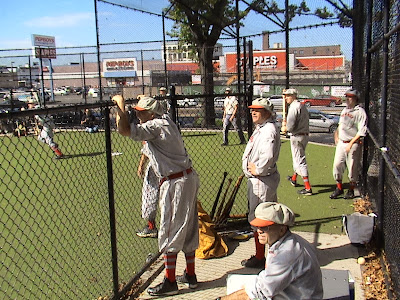Photo by Ann Colduvell
As in 2012, close to seven months of this year's posts combined a report on a Flemington Neshanock vintage base ball match and a historical connection or reflection. I've discussed before why I'm involved in vintage base ball (six years all told), but in addition to the personal benefits, it also facilitates my thinking and writing about the 19th century game. For example, while making the trip to Easton, Maryland for Sunday matches with the Talbot Fair Plays last April, I realized there was no similar 19th century experience as anyone foolish enough to play base ball on the Sabbath, risked jail time, fines and sometimes both. The result was a post that reported on the day's matches and took a brief look at the history of Sunday base ball.
It's important, however, to be careful in using vintage base ball to understand, write and talk about 19th century base ball. Just as Civil War re-enactors can't use real bullets, compromises on historical accuracy are part of vintage base ball such as using modern spikes for safety concerns. Even with those compromises, however, I think vintage base ball contributes to historical research, perhaps in a similar way that reminiscences and memory can enrich and bring color to contemporary documents and data.
Richard Hershberger (in civilian clothes) and the Neshanock at Gettysburg - photo by Mark Granieri
One thing I am sure of is that there's value in vintage players and historians working together. Last year Richard Hershberger was kind enough to attend a Neshanock match at the Gettysburg vintage base ball festival. There was so much conversation and inter-action on the side lines about base ball history that it sometimes diverted attention from the match itself. In fact, at one point the umpire came over not to discuss a call, but to be sure he had heard an historical point correctly. Richard has also provided Brad Shaw with contemporary evidence on how umpires called games, part of the continual effort to achieve the highest possible level of historical accuracy in the vintage game.
The Gettysburg festival was the subject of a post entitled "Weekend at Gettysburg" which discussed the vintage base ball festival, New Jersey's Civil War Sesquicentennial ceremonies at Gettysburg and the story of the 11th New Jersey's sacrifices in that historic battle. To my surprise the post got over 100 views within 24 hours, matched only by a recent post commemorating the 150th anniversary of the 33rd New Jersey's service during the battles for Chattanooga. There are no plans to turn A Manly Pastime into a Civil War blog, but there will be similar digressions in 2014 around other Sesquicentennial events, probably beginning in May. It's also likely that my research into the 1919 World Series will pop up at some point.
11th New Jersey monument at Gettysburg
Looking back at other 2013 blog topics, I realize that unintentionally, I wrote a fair amount about 19th century base ball in Newark. Among the subjects were Newark's first base ball grounds, early black base ball and the ever fascinating Antiquarian Knickerbockers. Currently I'm going through Newark newspapers from 1861 to 1870 (trust me, it's a lot of microfilm) as part of analyzing base ball's growth in New Jersey throughout the pioneer period (1855-1870). While any conclusions are premature, what I've seen reinforces Newark's importance in base ball's growth in New Jersey and beyond. Apparently close enough to Manhattan and Elysian Fields to attract Newark's young men to the "new" game, the city's role as a railroad hub seems to have been a major factor in the game's expansion in antebellum New Jersey. Indeed almost without exception, every community that had a base ball club before the Civil War also had a direct railroad connection to Newark.
1855 Newark Daily Advertiser account of Newark's first base ball clubs
All of this will get a lot of my research attention in 2014, some of which will undoubtedly find its way into the blog. One of the blog's major benefits for me is as vehicle to "think out loud" before anything gets cast in any more concrete form. As important as Newark base ball is, however, the rest of the state won't be neglected as the plan is to cover all of New Jersey. It will be especially interesting to look at the experience in southern new Jersey where there is no evidence of any base ball clubs through 1860 with the exception of Camden. And the Camden Club actually played Philadelphia town ball and didn't convert to the New York game until about 1864. Most suburban/rural communities in northern New Jersey seem to have gotten their first clubs in 1865 and 1866, will it be the same in south Jersey? Stay tuned.
The current plan is to begin the new year with a look at the original Flemington Neshanock which was short lived and had limited on-the-field success, but it's probably not a bad way to begin 2014 in a blog that moves back and forth between the past and the present. Barring something unforeseen that will begin the week of January 6th. Until then best wishes for the holidays and all of 2014. Thanks for taking the time to visit A Manly Pastime.
























































